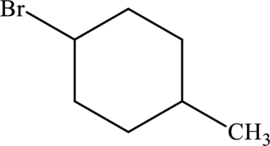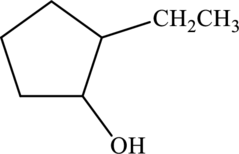
GENERAL,ORGANIC,+BIOCHEMISTRY(LL)-PKG
10th Edition
ISBN: 9781260699227
Author: Denniston
Publisher: MCGRAW-HILL HIGHER EDUCATION
expand_more
expand_more
format_list_bulleted
Concept explainers
Question
Chapter 11, Problem 11.83QP
(a)
Interpretation Introduction
Interpretation:
Equation for the addition reaction has to be written that produce the below given molecule.

(b)
Interpretation Introduction
Interpretation:
Equation for the addition reaction has to be written that produce the below given molecule.

(c)
Interpretation Introduction
Interpretation:
Equation for the addition reaction has to be written that produce the below given molecule.

(d)
Interpretation Introduction
Interpretation:
Equation for the addition reaction has to be written that produce the below given molecule.

Expert Solution & Answer
Want to see the full answer?
Check out a sample textbook solution
Students have asked these similar questions
no AI walkthrough
current image is wrong answer
a. Determine whether each of the Followery
Molecules
is in
the R- On the y-
Configuration
1-01"/
1-6-4
Br
4
I
el
Br
b. Draw The Fisher projection For all the
Meso compounds that can
exist FOR
The Following molenle
1- Refer to the monosaccharides below to answer each of the following question(s):
CH₂OH
CHO
CH₂OH
CH₂OH
0
H-
OH
0
0
HO-
H
H-
-OH
HO
H
HO H
H OH
HO- H
CH₂OH
H.
OH
HO
H
HO-
H
CH₂OH
CH₂OH
CH3
a. Sorbose
b. Rhamnose
c. Erythrulose
d. Xylulose
Classify each sugar by type; for example, glucose is an aldohexose.
a. Xylulose is ..
b. Erythrulose is .
c. Sorbose is ..
d. Rhamnose is ..
2- Consider the reaction below to answer the following question(s).
CHO
H
OH
CH₂OH
CH₂OH
HO-
H
HO
HO
+
H.
-OH
HO
OH
HO.
H
OH
OH
H
-OH
H
OH
CH₂OH
Q
Z
a.
Refer to Exhibit 25-11. Place a triangle around the anomeric carbon in compound Q.
Compound Z is:
b.
1. the D-anomer.
2. the a-anomer.
3. the ẞ-anomer.
4. the L-anomer.
c. Which anomer is the LEAST stable?
d. Q and Z are cyclic examples of:
a. acetals
b.
hemiacetals
c. alditols
d.
hemialditols
Chapter 11 Solutions
GENERAL,ORGANIC,+BIOCHEMISTRY(LL)-PKG
Ch. 11.2 - Name each of the following alkenes and alkynes...Ch. 11.2 - Prob. 11.2PPCh. 11.2 - Prob. 11.1QCh. 11.2 - Prob. 11.2QCh. 11.3 - Prob. 11.3PPCh. 11.3 - Prob. 11.4PPCh. 11.3 - Prob. 11.5PPCh. 11.3 - Prob. 11.3QCh. 11.3 - Prob. 11.4QCh. 11.3 - Prob. 11.5Q
Ch. 11.3 - Draw each of the cis-trans isomers in Question...Ch. 11.3 - Prob. 11.7QCh. 11.3 - Prob. 11.8QCh. 11.5 - Prob. 11.6PPCh. 11.5 - Prob. 11.7PPCh. 11.5 - Prob. 11.9QCh. 11.5 - Write balanced equations for the hydrogenation of...Ch. 11.5 - Prob. 11.11QCh. 11.5 - Prob. 11.12QCh. 11.5 - Prob. 11.8PPCh. 11.5 - Prob. 11.13QCh. 11.5 - Prob. 11.14QCh. 11.5 - Prob. 11.15QCh. 11.5 - Prob. 11.16QCh. 11.5 - Prob. 11.9PPCh. 11.5 - Prob. 11.17QCh. 11.5 - Prob. 11.18QCh. 11.5 - Prob. 11.19QCh. 11.5 - Prob. 11.20QCh. 11.5 - Write a balanced equation for the hydrobromination...Ch. 11.6 - Name the following compounds using the IUPAC and...Ch. 11.6 - Prob. 11.21QCh. 11.6 - Prob. 11.22QCh. 11 - Prob. 11.23QPCh. 11 - Prob. 11.24QPCh. 11 - Prob. 11.25QPCh. 11 - Prob. 11.26QPCh. 11 - Prob. 11.27QPCh. 11 - Prob. 11.28QPCh. 11 - Prob. 11.29QPCh. 11 - Prob. 11.30QPCh. 11 - Prob. 11.31QPCh. 11 - Prob. 11.32QPCh. 11 - Prob. 11.33QPCh. 11 - Prob. 11.34QPCh. 11 - Prob. 11.35QPCh. 11 - Prob. 11.36QPCh. 11 - Prob. 11.37QPCh. 11 - Prob. 11.38QPCh. 11 - Prob. 11.39QPCh. 11 - Prob. 11.40QPCh. 11 - Prob. 11.41QPCh. 11 - Prob. 11.42QPCh. 11 - Prob. 11.43QPCh. 11 - Prob. 11.44QPCh. 11 - Prob. 11.45QPCh. 11 - Prob. 11.46QPCh. 11 - Which of the following alkenes can exist as...Ch. 11 - Prob. 11.48QPCh. 11 - Prob. 11.49QPCh. 11 - Prob. 11.50QPCh. 11 - Prob. 11.51QPCh. 11 - Prob. 11.52QPCh. 11 - Prob. 11.53QPCh. 11 - Prob. 11.54QPCh. 11 - Prob. 11.55QPCh. 11 - Prob. 11.56QPCh. 11 - Prob. 11.57QPCh. 11 - Prob. 11.58QPCh. 11 - Prob. 11.59QPCh. 11 - Prob. 11.60QPCh. 11 - Prob. 11.61QPCh. 11 - Prob. 11.62QPCh. 11 - Prob. 11.63QPCh. 11 - Prob. 11.64QPCh. 11 - Prob. 11.65QPCh. 11 - Prob. 11.66QPCh. 11 - Prob. 11.67QPCh. 11 - Prob. 11.68QPCh. 11 - Prob. 11.69QPCh. 11 - Prob. 11.70QPCh. 11 - Prob. 11.71QPCh. 11 - Prob. 11.72QPCh. 11 - Prob. 11.73QPCh. 11 - Prob. 11.74QPCh. 11 - Prob. 11.75QPCh. 11 - Prob. 11.76QPCh. 11 - Prob. 11.77QPCh. 11 - Prob. 11.78QPCh. 11 - Prob. 11.79QPCh. 11 - Prob. 11.80QPCh. 11 - Prob. 11.81QPCh. 11 - Prob. 11.82QPCh. 11 - Prob. 11.83QPCh. 11 - Write an equation for the addition reaction that...Ch. 11 - Prob. 11.85QPCh. 11 - Draw the structure of each of the following...Ch. 11 - Prob. 11.87QPCh. 11 - Prob. 11.88QPCh. 11 - Prob. 11.89QPCh. 11 - Prob. 11.90QPCh. 11 - Prob. 11.91QPCh. 11 - Prob. 11.92QPCh. 11 - Draw each of the following compounds, using...Ch. 11 - Prob. 11.94QPCh. 11 - Prob. 11.95QPCh. 11 - Prob. 11.96QPCh. 11 - Prob. 11.97QPCh. 11 - Prob. 11.98QPCh. 11 - Prob. 11.99QPCh. 11 - Prob. 11.100QPCh. 11 - Prob. 11.101QPCh. 11 - Prob. 11.102QPCh. 11 - Prob. 11.103QPCh. 11 - What biological molecules contain purine rings?
Ch. 11 - Prob. 1MCPCh. 11 - Prob. 3MCPCh. 11 - Prob. 5MCPCh. 11 - Prob. 6MCPCh. 11 - Prob. 7MCPCh. 11 - Prob. 8MCPCh. 11 - Prob. 9MCPCh. 11 - Prob. 10MCP
Knowledge Booster
Learn more about
Need a deep-dive on the concept behind this application? Look no further. Learn more about this topic, chemistry and related others by exploring similar questions and additional content below.Similar questions
- i need help identifying the four carbon oxygen bonds in the following:arrow_forwardImagine each of the molecules shown below was found in an aqueous solution. Can you tell whether the solution is acidic, basic, or neutral? molecule HO H3N + The solution is... X O acidic OH O basic H3N-CH-C-O O neutral ○ (unknown) O acidic ○ basic CH2 CH 3-S-CH2 O neutral ○ (unknown) H3N O OH O acidic O basic Oneutral O (unknown) 0 H3N-CH-C-O CH3 CH CH3 O acidic O basic O neutral ○ (unknown) ? olo Ar BHarrow_forwardno Ai walkthroughs need other product (product in picture is wrong dont submit the same thing)arrow_forward
- I have a 2 mil plastic film that degrades after 22 days at 88C and at 61C takes 153 days. What is the failure at 47C in days.arrow_forwardIf a 5 film plastic film degraded in 30 days at 35C and the same film degraded in 10 days at 55 C and 2 days at 65C what would the predicted life time be at 22C for the same film?arrow_forwardno Ai walkthroughsarrow_forward
- I have a aqueous solution (175 ml) of iridium trichloride containing 8,750 ppm Iridium by ICP OES analysis. What is the percent concentration of Iridium trichloride in aquous solution and provide the concentration in moles per liter, percentage by weight.arrow_forwardno Ai walkthroughsarrow_forwardno Ai walkthroughsarrow_forward
arrow_back_ios
SEE MORE QUESTIONS
arrow_forward_ios
Recommended textbooks for you
 ChemistryChemistryISBN:9781305957404Author:Steven S. Zumdahl, Susan A. Zumdahl, Donald J. DeCostePublisher:Cengage Learning
ChemistryChemistryISBN:9781305957404Author:Steven S. Zumdahl, Susan A. Zumdahl, Donald J. DeCostePublisher:Cengage Learning ChemistryChemistryISBN:9781259911156Author:Raymond Chang Dr., Jason Overby ProfessorPublisher:McGraw-Hill Education
ChemistryChemistryISBN:9781259911156Author:Raymond Chang Dr., Jason Overby ProfessorPublisher:McGraw-Hill Education Principles of Instrumental AnalysisChemistryISBN:9781305577213Author:Douglas A. Skoog, F. James Holler, Stanley R. CrouchPublisher:Cengage Learning
Principles of Instrumental AnalysisChemistryISBN:9781305577213Author:Douglas A. Skoog, F. James Holler, Stanley R. CrouchPublisher:Cengage Learning Organic ChemistryChemistryISBN:9780078021558Author:Janice Gorzynski Smith Dr.Publisher:McGraw-Hill Education
Organic ChemistryChemistryISBN:9780078021558Author:Janice Gorzynski Smith Dr.Publisher:McGraw-Hill Education Chemistry: Principles and ReactionsChemistryISBN:9781305079373Author:William L. Masterton, Cecile N. HurleyPublisher:Cengage Learning
Chemistry: Principles and ReactionsChemistryISBN:9781305079373Author:William L. Masterton, Cecile N. HurleyPublisher:Cengage Learning Elementary Principles of Chemical Processes, Bind...ChemistryISBN:9781118431221Author:Richard M. Felder, Ronald W. Rousseau, Lisa G. BullardPublisher:WILEY
Elementary Principles of Chemical Processes, Bind...ChemistryISBN:9781118431221Author:Richard M. Felder, Ronald W. Rousseau, Lisa G. BullardPublisher:WILEY

Chemistry
Chemistry
ISBN:9781305957404
Author:Steven S. Zumdahl, Susan A. Zumdahl, Donald J. DeCoste
Publisher:Cengage Learning

Chemistry
Chemistry
ISBN:9781259911156
Author:Raymond Chang Dr., Jason Overby Professor
Publisher:McGraw-Hill Education

Principles of Instrumental Analysis
Chemistry
ISBN:9781305577213
Author:Douglas A. Skoog, F. James Holler, Stanley R. Crouch
Publisher:Cengage Learning

Organic Chemistry
Chemistry
ISBN:9780078021558
Author:Janice Gorzynski Smith Dr.
Publisher:McGraw-Hill Education

Chemistry: Principles and Reactions
Chemistry
ISBN:9781305079373
Author:William L. Masterton, Cecile N. Hurley
Publisher:Cengage Learning

Elementary Principles of Chemical Processes, Bind...
Chemistry
ISBN:9781118431221
Author:Richard M. Felder, Ronald W. Rousseau, Lisa G. Bullard
Publisher:WILEY
Chapter 4 Alkanes and Cycloalkanes Lesson 2; Author: Linda Hanson;https://www.youtube.com/watch?v=AL_CM_Btef4;License: Standard YouTube License, CC-BY
Chapter 4 Alkanes and Cycloalkanes Lesson 1; Author: Linda Hanson;https://www.youtube.com/watch?v=PPIa6EHJMJw;License: Standard Youtube License